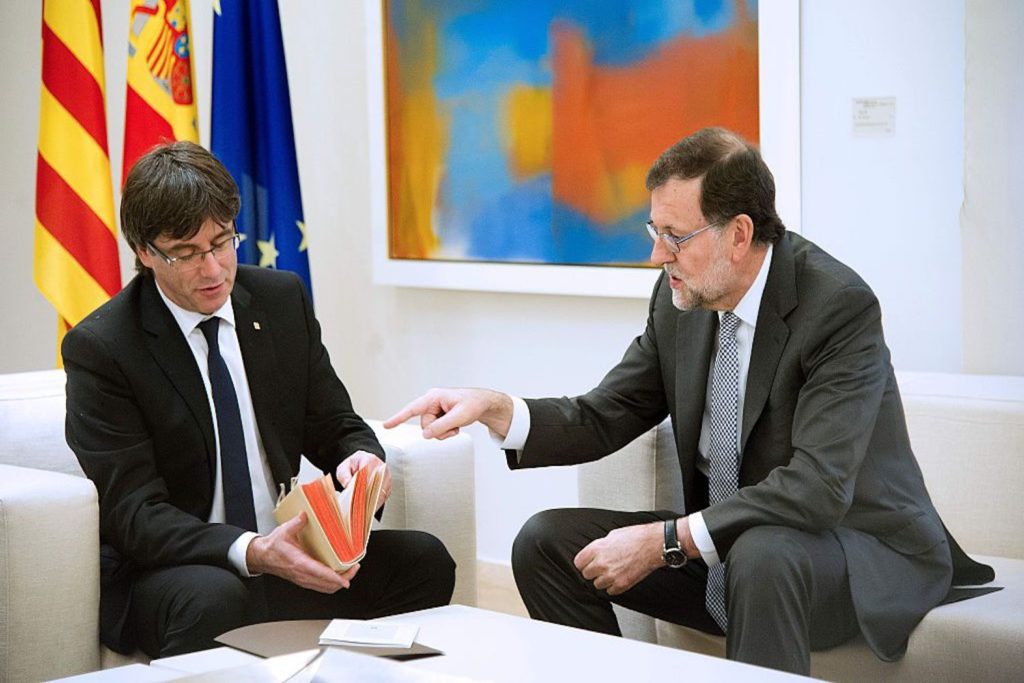28.12.2017 - 21:27
Since October, all across Catalonia, the lampposts, bridges, and facades have been decorated with yellow ribbons. It is not a Christmas tradition, but a show of solidarity with two pro-independence politicians and two well-known activists who have been in pretrial detention for almost two months. In general, yellow has become the color of resistance in this autonomous region, whose government failed in its attempt to gain independence from Spain last October. And it is this spirit of resistance that explains the results of last week regional elections.
Spain’s prime minister, Mariano Rajoy, called the regional election after the Catalan government held its own referendum on independence on Oct. 1. Madrid declared that referendum, which showed a large pro-independence majority, illegal. The Spanish government sent masked riot police to raid polling sites and confiscate ballot boxes and later called for a new “legitimate” election. Rajoy had hoped that a defeat of pro-independence parties in an election sanctioned by Spain’s central government would solve the Catalan conflict; he was wrong.
Against the odds, the three pro-independence parties together won the Dec. 21 regional poll with close to 48 percent of the votes with nearly 80 percent turnout, allowing them to keep the absolute majority in the Catalan Parliament. These results were a slap in the face to Rajoy. To add insult to injury, his People’s Party nearly disappeared in Catalonia, winning only four seats out of 135. His rivals on the Spanish right, the Ciudadanos party, won 36 seats — a result that would have been unthinkable a few years ago.
In the week since the vote, nationalists in the Spanish press have not been kind to Rajoy. They argue that it was a mistake to call for a snap election just hours after suspending Catalan self-rule in late October. However, at that point, Rajoy had no other option. A sustained suspension of Catalonia’s autonomy, the preferred solution of hardcore Spanish nationalists, could have led to civil strife.
For all his recent faults, the Spanish premier’s blunder in fact came much earlier, when he failed to address the Catalan government’s grievances, such as unfair fiscal policies or the lack of recognition of Catalan national identity.
For a long time, Rajoy seemed to buy the so-called souffle theory, which held that the independence movement would grow but eventually deflate and therefore there was no need to make concessions. Seen in that light, the sudden rise of the movement in 2012 was linked to Spain’s recession and would naturally weaken along with an economic recovery. But the conflict has much deeper roots, and its main trigger was the failed process to expand Catalonia’s autonomy a decade ago. During the discussion of the new autonomy law in mid-2000s, Rajoy’s People’s Party launched a strong campaign against the law that led to the boycott of Catalan products, infuriating most Catalans. Once the law was passed by both the Catalan and the Spanish parliaments, the Constitutional Court struck down several of its main provisions, such as the article that recognized Catalonia as a “nation.”
Once it became evident that the pro-independence movement would not just go away, Rajoy chose to ignore its leaders and let the judicial system deal with any challenge to the authority of the Spanish state. As a result of this policy, the exiled Catalan president, Carles Puigdemont, is now in Brussels, and his vice president, Oriol Junqueras, is in prison. They face possible 30-year prison sentences, despite having never used violence. More than 100 highly regarded Spanish lawyers have stated that the “sedition” and “rebellion” charges against them are baseless, and many Catalans consider them political prisoners. Yet instead of seeking a political solution for what is a political problem, Rajoy has let the conflict fester and treated it as a “law and order” problem. And by outsourcing resolution of the Catalan conflict to the judiciary, he now risks losing control of events.
The secessionist leaders are not without blame. The Catalan government’s worst mistake was to promote a declaration of independence after a referendum with only a 43 percent turnout. The argument that this percentage would have been higher had the Spanish police not brutally repressed voters does not legitimize such a foolish move. The consequences of the unilateral declaration were easy to predict: No country recognized the new “republic,” self-rule was suspended, and Catalan society became more bitterly divided between pro- and anti-independence citizens.
In a rare show of self-criticism, pro-independence Catalan leaders recognized some of their mistakes during the electoral campaign. “The Catalan government was not ready to enforce independence,” Clara Ponsati, former regional minister for education, declared from Brussels. The two biggest secessionist coalitions, Together for Catalonia and Republican Left of Catalonia, which together got 66 seats and are expected to form the new regional government, have stated in their party platforms the need to negotiate with Madrid and have rejected the idea of a unilateral solution to the conflict.
While this is a positive development that may soothe tensions, a serious dialogue between the two sides remains unlikely. To begin with, the rise of Ciudadanos in opinion polls threatens the hegemony that Rajoy’s People’s Party has enjoyed within the Spanish right since the late 1980s, and this will probably lead to a nationalist bidding war between the two parties. In fact, Ciudadanos’ leader, Albert Rivera, has already accused Rajoy of being too soft on secessionists. Stirring anti-Catalan feelings has always been a successful electoral strategy for Spanish right-wing politicians, so it is hard to imagine them abandoning it now.
The most likely scenario for the foreseeable future is an entrenched conflict. Neither side seems able to “win,” and Madrid is rejecting any European Union mediation. Canada and the United Kingdom have taken an alternative approach. Both countries held self-determination referendums to address similar demands from Quebec and Scotland. And in both cases, the secessionists lost and tensions eventually receded.
Madrid could also win such a vote if it made a few concessions, such as offering more fiscal and political autonomy to Catalonia. However, Rajoy has refused to even discuss the conditions under which such a vote could be held, insisting that the law forbids it. But if the Spanish government took the issue seriously, it would not be so difficult to amend the constitution to allow for it.
The other long-term solution would be to turn Spain into a confederation with full recognition of its national minorities. Unlike a referendum, such a shift would not create winners and losers. In private conversations, some pro-independence Catalan politicians say that they could accept it as a compromise. However, Spanish leaders do not seem ready for it; this change would force the Spanish state to rethink the way it has defined itself for the last three centuries. Confederation has worked reasonably well in the past. This was the arrangement between Catalonia and Spain from the marriage of Queen Isabella of Castile and King Ferdinand of Aragon in the late 15th century until the War of Succession in the early 18th century.
So far, the Spanish political class doesn’t see the need to pay such a high price to put an end to the “Catalan question.” Many Spanish politicians and intellectuals consider the conflict in Catalonia a chronic pain, but not a mortal disease that really threatens the integrity of the nation. They may be correct for now, given the polarization of Catalan society.
But the independence of Catalonia cannot be ruled out in the long run if the Spanish government continues to rely on painkillers rather than proposing a genuine remedy. According to polls, in addition to the roughly 50 percent who want independence, 20 percent of Catalans would like to have more autonomy; together, they represent a clear majority against the status quo. In addition, support for independence is the weakest among older voters, probably because many of them were born in other regions of Spain and immigrated to Catalonia during the economic boom of the 1960s. Support for independence could therefore grow simply due to generational change over the next 20 years.
At the moment, however, Prime Minister Rajoy and his political adversaries have more pressing concerns than the emergence of a hypothetical threat by 2040; Spain is currently being led by a minority government, and the prospect of snap elections is quite likely. This is why the conflict between Catalonia and Spain has no end in sight.
BY RICARD GONZALEZ | DECEMBER 27, 2017, 2:56 PM
More at: Foreign Policy

